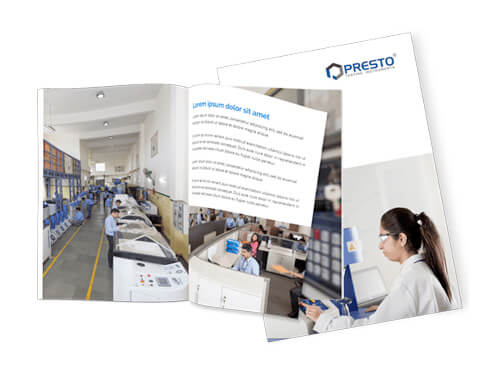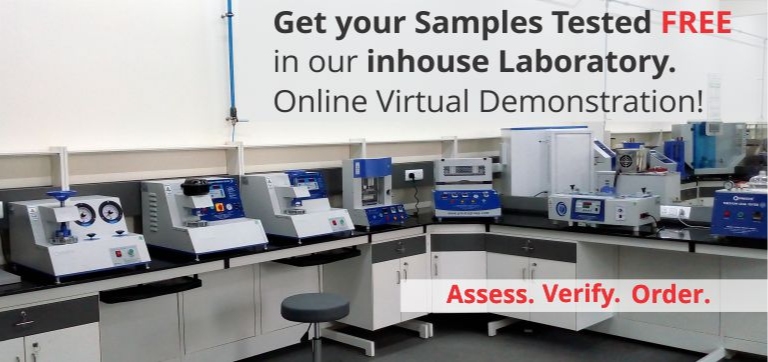Bursting strength tester - index of strength and performance

Gaurav Malhotra
27-06-2024
Presto bursting strength tester is an instrument for measuring the resistance of materials that crack or burst under certain conditions. It puts hydraulic or pneumatic pressure gradually on the concerned device until it cracks. It tells you about the strength and durability of the device.
Why is it important?
Quality Assurance: It is necessary to ensure the quality of each product and combat risks or any dysfunction. The materials should be able to face certain amounts of force without compromising on their ability to perform their designated function.
Developing the product: If you are in the development phase, no worries! This tester will assist you on the regular to assess the overall performance of your product - measuring the strength of the material so that you can make changes if requiring any. It will also guide you to make design changes.
Regulatory Compliance: Industries can fulfill their regulatory requirements and complying with them saves them from a multitude of legal issues and the like.
Important characteristics of Presto Bursting Strength Testers:
1) Accurate and consistent test results are ensured by the advanced testers' exact control over pressure delivery, courtesy of the busting strength tester manufacturer.
2) Safety Features: During testing, built-in safety devices including pressure release valves and secure sample clamps guard personnel and equipment.
3) Data Acquisition: A lot of contemporary testers have digital displays and data logging features, which enable real-time test result monitoring and recording.
4) Versatility: The busting strength tester machine is adaptable to varied industries and testing requirements since it can handle a wide range of sample sizes and forms.
Applications of Bursting Strength Testers in the Packaging Industry:
Assessing the material’s strength usually becomes the deciding factor for many applications, especially in the packaging industry.
Textiles and Fabrics: Knowing the tensile strength of each textile is important for knowing where it can be used for different purposes in different commercial settings, clothing, furniture etceter, and hence for further development of the product.
Paper and Pulp: Evaluating paper goods to fulfill performance requirements and consumer expectations, such as tissues, cardboard tubes, and specialty papers.
Leather and Rubber Products: Analyzing the burst strength of rubber membranes, leather goods, and associated materials for use in the industrial, automotive, and footwear sectors.
The strength is determined by applying a hydraulic pressure under test circumstances to a circular section of the CFB specimen through a rubber diaphragm. Using a digital indicator, the force necessary to cause the board to burst or completely rupture is determined.
A quality CFB's rating is based on its bursting strength. It is based on an Intel chip micro controller. It also provides a peak hold facility for memory back-up and a clear LED screen for easy user-friendly access and controls. It is definitely worth the bursting strength tester price. It is especially convenient, economical and excellent for testing paper and corrugated boxes with unique 2 point Calibration for low or high range. You don’t even need a change of diaphragm here!
Other available models :
Includes printer
Computerised (PBD- 400 C)
To guarantee precise and trustworthy test results, a bursting strength tester must be calibrated. In order to ensure proper calibration, the instrument's settings must be checked and adjusted to match recognized standards or reference values. A general guide on calibrating a bursting strength tester can be found here:
Getting Set for Calibration
Go through the manual: Learn how to calibrate your particular kind of bursting strength tester by familiarizing yourself with the manufacturer's instructions and guidelines. The handbook will include details on particular operations and requirements unique to your device.
Assemble Equipment: Get ready the tools required for the calibration, which could be:
reference standards or calibration weights with established bursting strengths.
calibrated transducers or pressure gauges (if applicable).
Instruments for modifying and optimizing the examination.
3. Assure Safety: Make sure the tester is turned off and that all safety procedures are followed before beginning calibration. If required, put on the proper personal protective equipment (PPE).
Steps in Calibration:
1. Verify Conditions and Setup: Make sure the tester is placed in a stable area with enough room for access and operation.
To ensure that the sample is held firmly during calibration, make sure the clamping mechanism is clean and in working order.
2. Zero Adjustment (if applicable): Make that your tester is correctly calibrated to read zero pressure in the absence of any load or pressure. To zero the instrument, adhere to the manufacturer's instructions.
3. Apply Calibration Standard: As directed by the manufacturer, insert the calibration weights or reference standard into the tester's clamping mechanism.
Make certain the reference standard is positioned and aligned within the tester in a secure manner.
4. Apply Pressure: Using the hydraulic or pneumatic system of the tester, gradually apply pressure to the reference standard.
As pressure is applied, keep an eye on the pressure reading that appears on the gauge or digital interface of the tester.
5. Compare Readings: Compare the tester's pressure reading to the calibration standard's known bursting strength value.
To match the expected pressure reading, make any necessary adjustments to the tester's calibration controls or settings.
6. Repeat if Required: Make sure all corrections are done precisely and carefully if the first readings do not correspond to the predicted values. If this happens, repeat the calibration procedure.
Fine-tune the tester by making minor adjustments as needed until it consistently yields correct readings.
Frequently asked questions on Presto Burning Strength Tester:
Question 1) How can the product contribute to product research and development?
Answer: Data is invaluable here, and this device does the exact job of gathering data that guides material selection processes. It aids engineers and designers in optimizing product designs to raise safety standards, increase fire resistance, and satisfy consumers' demands for dependability and quality.
Question 2) What are the safety considerations while using it?
Answer: a) Well-ventilated environment following fire safety protocols is essential to conduct the testing.
b) Follow Presto manual guidelines for the procedure. Use PPE for flammable materials.
Do not wait any further! Get onto our website!
Reach out to us through a phone call at +91 9210903903 or directly dropping us an e-mail at info@prestogroup.com.
you may also like
- The Ultimate Guide to Universal Testing Machines (UTM)
- Guide to Bursting Strength Tester: Working, Benefits & Price
- Ultimate Guide to Melt Flow Index Tester: Operations, Advantages, and Uses
- A Complete Guide to Box Compression Tester: Methods & Applications
- Hot air oven not working? Common problems & fixing issues
Recent News
- Paper & Packaging Testing Instruments
- Paint, Plating & Coating Testing Instruments
- Plastic & Polymer Testing Instruments
- Environmental Testing Chambers
- PET & Preform Testing Instruments
- Color Measuring Testing Instruments
- View Entire Range Instruments

Catalogue 2023
Get information about new product launches, research, innovation and endeavors at Presto.
download Free Copy
Get a Quote

